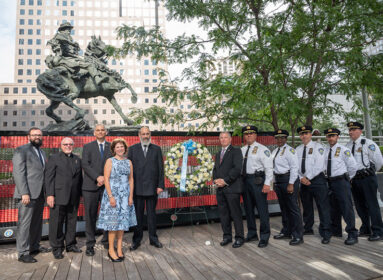
How can the newspaper justify flagrantly misleading its readers?
By Gilead Ini
(CAMERA) Amr Khamour was killed last January while taking part in an attack on Israeli soldiers.
The PFLP, a Palestinian terrorist group, described the teen as one of its members in an official statement. In a goodbye note Khamour wrote prior to the incident, he singled out the PFLP for acclaim. He was wrapped for burial in a PFLP flag, wearing a PFLP headband, while being carried by pallbearers wearing the same.
Amr Khamour, in other words, was clearly affiliated with the PFLP. But in a July 5 story, The New York Times insisted he was “not affiliated with the territories’ armed groups.” Although editors were subsequently informed of the affiliation, the falsehood remained uncorrected.
How could the newspaper justify flagrantly misleading its readers? One theory relates to an earlier story published by the piece’s coauthors, Raja Abdulrahim and Hiba Yazbek. Late last year, the reporters argued that Palestinian groups will sometime claim as members casualties who weren’t in fact affiliated with the groups.
But the possibility that terror groups might sometimes overstep can’t be an open license for The New York Times to disregard—and effectively deny—glaring evidence of affiliation. With so many indications that Khamour was linked to the PFLP, the authors would need to be clear with readers about their reasoning if they believe he wasn’t actually tied to th
In the earlier story, moreover, the reporters described parents pushing back against terrorist organizations when they believed their sons were wrongly claimed as members. In Amr Khamour’s case, the opposite was true. His mother donned the PFLP’s signature red keffiyeh while mourning, further confirming the affiliation.
There’s a different explanation for why Abdulrahim and Yazbek concealed the terror affiliation. Before joining the Times, both were prone to extreme and dishonest anti-Israeli rhetoric. And since they joined the newspaper, they’ve consistently tilted the scales to skew stories against the Jewish state.
They did the same, in fact, throughout their July 5 piece.
Along with the distortion about Amr Khamour, for example, the authors stated, that “Palestinian society has long lionized ‘martyrs’—anyone killed by Israeli forces.” Here, the authors toy with the definition to erase Palestinian violence against Israeli civilians. Prominent among the “martyrs” lionized in Palestinian society are suicide bombers, who killed Israelis but were certainly not “killed by Israeli forces.”
Abdulrahim and Yazbek also referred to terror leader Ibrahim al-Nabulsi as “a member of a local armed group in Nablus, who left a brief voice recording as he was cornered by Israeli forces in the moments before he was killed.” To state only that al-Nabulsi was “cornered” and then “killed” is an flagrant error of omission, which conceals the pertinent circumstances of his death. As reported a year earlier by The New York Times and others, the Palestinian militant was killed “in a shootout.” Those three words provide essential information. But here again, the reporters act to erase violence by Palestinians against Israelis.
Similar to how al-Nabulsi’s confrontation with soldiers was erased, the piece also neglected to share that the most or all of those killed in a military operation in Jenin this summer were involved in clashes with troops. The reporters described only an Israeli “military incursion … in the Palestinian city of Jenin, killing at least 12 Palestinians.” Readers are left unaware that eight of the dead were Islamic Jihad fighters, one was a Hamas fighter and at least some (if not all) of the remaining three appeared to also be involved in confrontations. Yet again, Palestinian violence is erased to cast Israel as an arbitrary aggressor.
Finally, the authors reported that “at least 155 Palestinians have been killed this year, mostly during Israeli military raids.” Under other New York Times bylines, the newspaper has acknowledged that most of that number were killed during gunbattles and other clashes against the army. There is a substantive difference between “raids” and “clashes,” and the latter word is notably more precise and informative.
But it seems precise and informative reporting isn’t the goal.
Originally published by CAMERA.
Gilead Ini is a senior research analyst at CAMERA. His commentary has appeared in numerous publications, including The Jerusalem Post, The Christian Science Monitor, Columbia Journalism Review and National Review.
PHOTO: NYTimes
CAP: The New York Times distribution truck. Credit: ChameleonsEye/Shutterstock.








 Southern New England Jewish Ledger
Southern New England Jewish Ledger









